java.io.File类:文件和路径名的抽象表示形式,与平台无关
File能新建、删除、重命名文件和文件夹,单file不能访问文件的内容,如果需要访问文件的内容,则要使用输入、输出流
file可以作为参数传递给流的构造函数
File的常用构造函数:
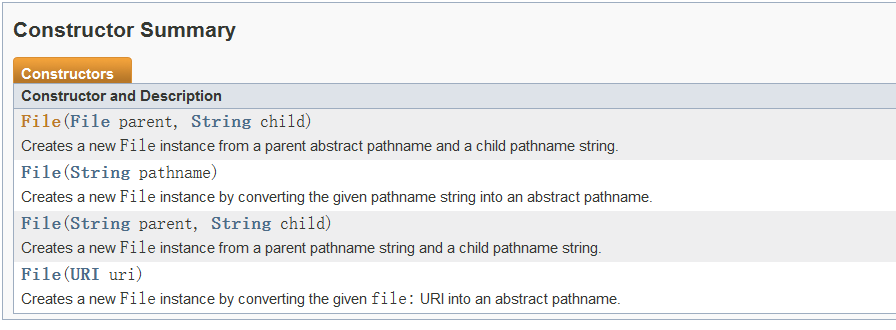
File的常用方法:
查看文件的属性:

验证文件、文件夹是否存在:
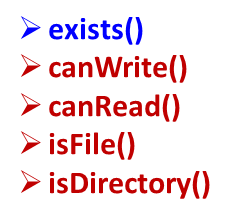
获取文件、文件的信息

与文件相关的操作
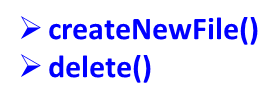
与目录相关的操作
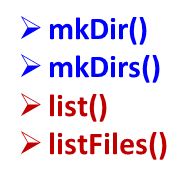
java io的原理:
IO流用来处理设备之间的数据传输
在java程序中,对于数据的输入、输出操作以流的方式进行
java.io包下提供了各种的类和接口,以获取不同种类的数据,并通过标准的方法进行输入、输出操作
输入InputStream、Reader:读取外部的数据(磁盘、光盘等外部设备的数据)到程序(内存中)
输出OutputStream、Writer:将程序(内存)中的数据输出到磁盘、光盘等外部设备
流的分类::
按操作数据单位的不同分为:字节流(8个字节)、字符流(16个字节)
按数据的流向分为:输入流、输出流
按流的角色不同:节点流,处理流

InputSteam和Reader是输入流的基类
InputStream

1 public void fileInputStream() throws Exception { 2 3 // 1.创建一个File类的对象。 4 File file = new File("hello.txt"); 5 6 // 2.创建一个FileInputStream类的对象 7 FileInputStream fis = new FileInputStream(file); 8 9 // 3.调用FileInputStream的方法,实现file文件的读取。 10 /* 11 * read():读取文件的一个字节。当执行到文件结尾时,返回-1 12 */ 13 // int b = fis.read(); 14 // while(b != -1){ 15 // System.out.print((char)b); 16 // b = fis.read(); 17 // } 18 19 20 int b; 21 while ((b = fis.read()) != -1) { 22 System.out.print((char) b); 23 } 24 25 // 4.关闭相应的流 26 fis.close(); 27 }
public void fileOutputStream() { // 1.创建一个File对象,表明要写入的文件位置。 // 输出的物理文件可以不存在,当执行过程中,若不存在,会自动的创建。若存在,会将原有的文件覆盖 File file = new File("hello2.txt"); // 2.创建一个FileOutputStream的对象,将file的对象作为形参传递给FileOutputStream的构造器中 FileOutputStream fos = null; try { fos = new FileOutputStream(file); // 3.写入的操作 fos.write(new String("I love China!").getBytes()); } catch (Exception e) { e.printStackTrace(); } finally { // 4.关闭输出流 if (fos != null) { try { fos.close(); } catch (IOException e) { // TODO Auto-generated catch block e.printStackTrace(); } } } }
1 public void copy() { 2 // 1.提供读入、写出的文件 3 File file1 = new File(""); 4 File file2 = new File(""); 5 // 2.提供相应的流 6 FileInputStream fis = null; 7 FileOutputStream fos = null; 8 try { 9 fis = new FileInputStream(file1); 10 fos = new FileOutputStream(file2); 11 // 3.实现文件的复制 12 byte[] b = new byte[20]; 13 int len; 14 while ((len = fis.read(b)) != -1) { 15 // fos.write(b);//错误的写法两种: fos.write(b,0,b.length); 16 fos.write(b, 0, len); 17 } 18 } catch (Exception e) { 19 e.printStackTrace(); 20 } finally { 21 if (fos != null) { 22 try { 23 fos.close(); 24 } catch (IOException e) { 25 e.printStackTrace(); 26 } 27 } 28 if (fis != null) { 29 try { 30 fis.close(); 31 } catch (IOException e) { 32 e.printStackTrace(); 33 } 34 } 35 36 } 37 }
Reader

1 public void fileReader(){ 2 FileReader fr = null; 3 try { 4 File file = new File(""); 5 fr = new FileReader(file); 6 char[] c = new char[24]; 7 int len; 8 while((len = fr.read(c)) != -1){ 9 String str = new String(c, 0, len); 10 System.out.print(str); 11 } 12 }catch (IOException e) { 13 // TODO Auto-generated catch block 14 e.printStackTrace(); 15 }finally{ 16 if(fr != null){ 17 try { 18 fr.close(); 19 } catch (IOException e) { 20 // TODO Auto-generated catch block 21 e.printStackTrace(); 22 } 23 } 24 } 25 26 }
OutputStream
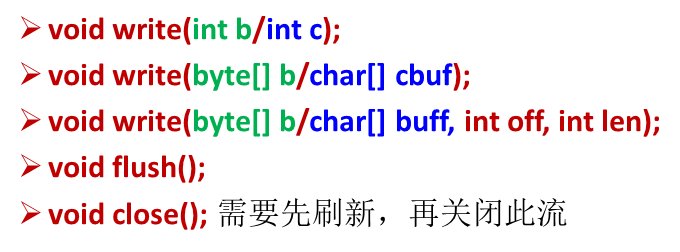
因为字符流直接以字符进行操作单位,所以Writer可以用字符串来替换字符数组,即以String作为参数

1 public void fileReaderWriter(){ 2 //1.输入流对应的文件src一定要存在,否则抛异常。输出流对应的文件dest可以不存在,执行过程中会自动创建 3 FileReader fr = null; 4 FileWriter fw = null; 5 try{ 6 //不能实现非文本文件的复制 7 // File src = new File(""); 8 // File dest = new File(""); 9 File src = new File(""); 10 File dest = new File(""); 11 //2. 12 fr = new FileReader(src); 13 fw = new FileWriter(dest); 14 //3. 15 char[] c = new char[24]; 16 int len; 17 while((len = fr.read(c)) != -1){ 18 fw.write(c, 0, len); 19 } 20 }catch(Exception e){ 21 e.printStackTrace(); 22 }finally{ 23 if(fw != null){ 24 try { 25 fw.close(); 26 } catch (IOException e) { 27 // TODO Auto-generated catch block 28 e.printStackTrace(); 29 } 30 } 31 if(fr != null){ 32 try { 33 fr.close(); 34 } catch (IOException e) { 35 // TODO Auto-generated catch block 36 e.printStackTrace(); 37 } 38 } 39 } 40 }
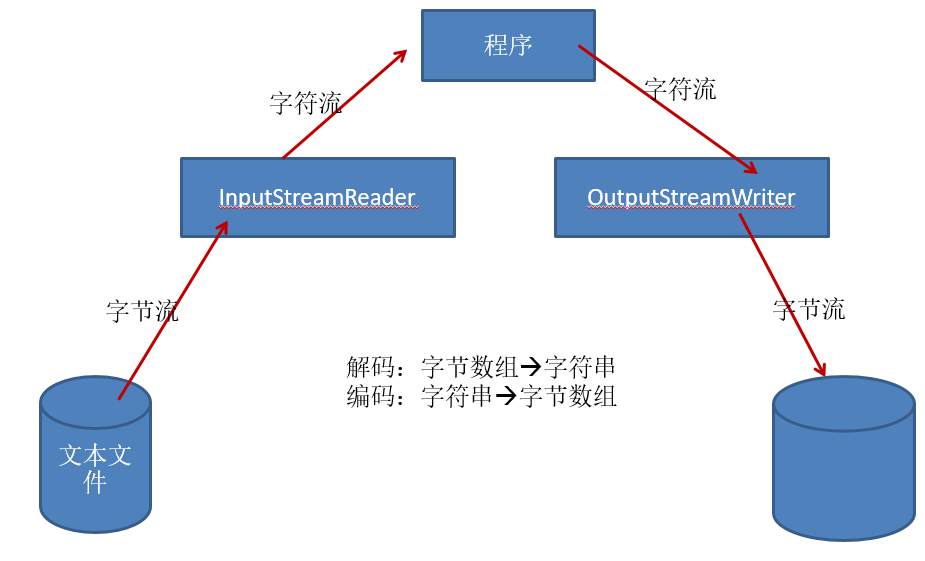
1 /* 2 * 实现字节流与字符流之间的转换: 3 * 转换流:InputStreamReader OutputStreamWriter 4 * 编码:字符串 --->字节数组 5 * 解码:字节数组--->字符串 6 */ 7 @Test 8 public void test1(){ 9 BufferedReader br = null; 10 BufferedWriter bw = null; 11 try { 12 //解码 13 File file = new File("dbcp.txt"); 14 FileInputStream fis = new FileInputStream(file); 15 InputStreamReader isr = new InputStreamReader(fis, "GBK"); 16 br = new BufferedReader(isr); 17 //编码 18 File file1 = new File("dbcp4.txt"); 19 FileOutputStream fos = new FileOutputStream(file1); 20 OutputStreamWriter osw = new OutputStreamWriter(fos, "GBK"); 21 bw = new BufferedWriter(osw); 22 String str; 23 while((str = br.readLine()) != null){ 24 bw.write(str); 25 bw.newLine(); 26 bw.flush(); 27 } 28 }catch (IOException e) { 29 e.printStackTrace(); 30 }finally{ 31 if(bw != null){ 32 try { 33 bw.close(); 34 } catch (IOException e) { 35 e.printStackTrace(); 36 } 37 38 } 39 if(br != null){ 40 try { 41 br.close(); 42 } catch (IOException e) { 43 e.printStackTrace(); 44 } 45 46 } 47 } 48 49 }
常见的字符编码:
ASCII:美国标准的信息交换码,用一个字节的7位表示
ISO-8859-1:拉丁码表,欧洲码表,用一个字节的8位表示
GB2312:中国的中文编码表
GBK:中国的中文编码表
Unicode:国际标准码,融合了多种文字,所有文字都用两个字节来表示,java语言使用的就是这个编码
UTF-8:最多使用3个字节来表示一个字符
转换流的编码使用:
可以将字符按指定格式的编码进行存储
可以对字符按指定格式的编码进行解读,有构造函数完成
标准的输入、输出流:
System.in和System.out分别代表了系统的标准输入和输出设备
System.in的类型是InputStream,System.out的类型是PrintStream
通过System.setIn(), System.setOut()方法对默认设备进行更改
1 public void demo(){ 2 BufferedReader br = null; 3 try { 4 InputStream is = System.in; 5 InputStreamReader isr = new InputStreamReader(is); 6 br = new BufferedReader(isr); 7 String str; 8 while(true){ 9 System.out.println("请输入字符串:"); 10 str = br.readLine(); 11 if(str.equalsIgnoreCase("e") || str.equalsIgnoreCase("exit")){ 12 break; 13 } 14 String str1 = str.toUpperCase(); 15 System.out.println(str1); 16 } 17 } catch (IOException e) { 18 e.printStackTrace(); 19 }finally{ 20 if(br != null){ 21 try { 22 br.close(); 23 } catch (IOException e) { 24 // TODO Auto-generated catch block 25 e.printStackTrace(); 26 } 27 28 } 29 } 30 }